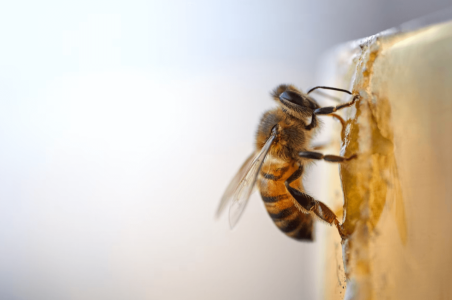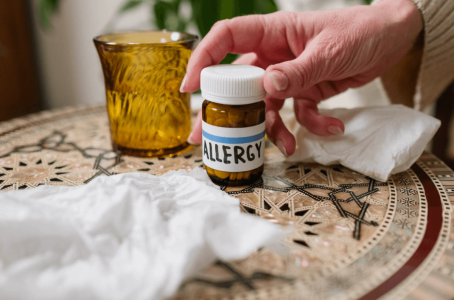Buzzing discovery: Former paramedic shares life-saving bee sting trick
- Replies 8
Summer - with its warm, sun-kissed days and carefree nights, what's not to love? But let's face it, no season is perfect, and summer has its share of troubles.
As the temperatures soar, creepy crawlies come out of hiding, and one of the summertime pests we can't seem to shake is the humble bee. So, it's crucial to stay alert when enjoying the great outdoors.
But what happens when the inevitable bee sting occurs? Don't panic! Do you know the correct way to remove the bee sting and reduce the reaction?
Lucky for you, an Aussie mum, who is also a former paramedic, is here to share some expert advice. Take a deep breath and keep reading for an easy solution to your bee sting woes!

Nikki Jurcutz, who manages the page Tiny Hearts Education on social media, has just dropped a buzz-worthy video on Instagram, showing a simple but oh-so-effective life hack for dealing with pesky bee stings.
In the video, Nikki reveals her secret weapon against bee stings. But watch out, she warns against the classic mistake of trying to pinch the sting out with your fingers or tweezers – this will only make things worse by pushing more venom into your system.
Instead, Nikki suggests a gentler approach by scraping away the sting with a hard card, like an old credit card or a trusty business card. This trick is so simple, you'll be saying 'why didn't I think of that?' in no time.
The best part of Nikki's hack? It's so easy to do! All you need to do is lay a hard card, like a credit card or business card, flat on the bee sting, and slowly scrape it away towards the venom sac.
But wait, some of you may be thinking, 'What if I don't have a credit card on hand when a bee decides to sting me?' Don't worry! Any hard object will do the trick – even a piece of wood or your trusty fingernail.
Nikki's bee sting hack is all the buzz on Instagram and her followers are raving about it! People are grateful to have a solution that actually works, with one user commenting, 'Oh, this is so helpful! Thank you!'
Another shared their painful story of using tweezers to remove a bee sting, resulting in 'huge swelling.' But, with Nikki's trick, they won't be making that mistake again. They said, 'From now on I'll be doing this. Thank you!'


Bee stings can cause different reactions in people depending on their individual sensitivity and the amount of venom injected by the bee.
Common symptoms of bee stings include pain, redness and swelling at the site of the sting, as well as itchiness and hives in some cases. In rare cases, bee stings can trigger anaphylactic shock, which is a severe allergic reaction and can be life-threatening.
If someone is stung by a bee, the immediate treatment is to remove the sting as quickly as possible. As explained earlier, tweezers should not be used, as this could cause more venom to enter the body.
Instead, a card or other flat, stiff item should be used to scrape out the sting. Next, wash the affected area with soap and water. This helps to clean the area and prevent infection.
After that, apply a cold compress to reduce swelling. You can either use a cold pack, a bag of frozen vegetables, or a cloth dampened with cold water. Hold the compress on the affected area for about 10-15 minutes, then remove for 10 minutes, and repeat as needed.

Bee sting victims should also take an antihistamine to reduce itching and swelling. Over-the-counter antihistamines such as diphenhydramine (Benadryl) can help relieve symptoms. Follow the instructions on the package or consult with a doctor for the recommended dose.
If symptoms such as difficulty breathing or swallowing occur, seek medical attention immediately. These symptoms can be signs of a severe allergic reaction (anaphylaxis) and prompt medical attention is necessary. Anaphylaxis can be life-threatening and requires emergency treatment.
This bee sting trick proves that even the simplest of solutions can be game-changers. So, whether you're on a picnic, hiking, or just enjoying a lazy afternoon in the park, you can relax knowing that you're equipped to handle any buzzing emergencies that may arise.
Members, we hope you found this article helpful! And don't forget, if you've got any buzz-worthy tips of your own, we'd love to hear them in the comments section! Let's spread the buzz and make this the summer of sting-free fun.
As the temperatures soar, creepy crawlies come out of hiding, and one of the summertime pests we can't seem to shake is the humble bee. So, it's crucial to stay alert when enjoying the great outdoors.
But what happens when the inevitable bee sting occurs? Don't panic! Do you know the correct way to remove the bee sting and reduce the reaction?
Lucky for you, an Aussie mum, who is also a former paramedic, is here to share some expert advice. Take a deep breath and keep reading for an easy solution to your bee sting woes!

The best way to treat a bee sting is by removing the stinger - but not with tweezers, as many would assume. Credit: Unsplash/leandro fregoni.
Nikki Jurcutz, who manages the page Tiny Hearts Education on social media, has just dropped a buzz-worthy video on Instagram, showing a simple but oh-so-effective life hack for dealing with pesky bee stings.
In the video, Nikki reveals her secret weapon against bee stings. But watch out, she warns against the classic mistake of trying to pinch the sting out with your fingers or tweezers – this will only make things worse by pushing more venom into your system.
Instead, Nikki suggests a gentler approach by scraping away the sting with a hard card, like an old credit card or a trusty business card. This trick is so simple, you'll be saying 'why didn't I think of that?' in no time.
The best part of Nikki's hack? It's so easy to do! All you need to do is lay a hard card, like a credit card or business card, flat on the bee sting, and slowly scrape it away towards the venom sac.
But wait, some of you may be thinking, 'What if I don't have a credit card on hand when a bee decides to sting me?' Don't worry! Any hard object will do the trick – even a piece of wood or your trusty fingernail.
Nikki's bee sting hack is all the buzz on Instagram and her followers are raving about it! People are grateful to have a solution that actually works, with one user commenting, 'Oh, this is so helpful! Thank you!'
Another shared their painful story of using tweezers to remove a bee sting, resulting in 'huge swelling.' But, with Nikki's trick, they won't be making that mistake again. They said, 'From now on I'll be doing this. Thank you!'
Key Takeaways
- An Aussie mum, who is a former paramedic, has shared a video on Instagram on what to do if stung by a bee.
- She advises against using tweezers or pulling out the stinger as it could further spread the venom.
- The proper way to remove the sting is to gently use a hard object, such as a card or a firm piece of bark, to scrape it out by swiping towards the venom sac.
- Many parents appreciated the tip and shared their own experiences, with some suggesting using a fingernail instead of a card.

People's reactions to bee stings vary depending on their unique sensitivity and the amount of venom administered by the bee. Credit: Unsplash/Eduardo Gorghetto.
Bee stings can cause different reactions in people depending on their individual sensitivity and the amount of venom injected by the bee.
Common symptoms of bee stings include pain, redness and swelling at the site of the sting, as well as itchiness and hives in some cases. In rare cases, bee stings can trigger anaphylactic shock, which is a severe allergic reaction and can be life-threatening.
If someone is stung by a bee, the immediate treatment is to remove the sting as quickly as possible. As explained earlier, tweezers should not be used, as this could cause more venom to enter the body.
Instead, a card or other flat, stiff item should be used to scrape out the sting. Next, wash the affected area with soap and water. This helps to clean the area and prevent infection.
After that, apply a cold compress to reduce swelling. You can either use a cold pack, a bag of frozen vegetables, or a cloth dampened with cold water. Hold the compress on the affected area for about 10-15 minutes, then remove for 10 minutes, and repeat as needed.

An antihistamine can help ease the victim's discomfort from the sting and the swelling it causes. Credit: Pexels/cottonbro studio.
Bee sting victims should also take an antihistamine to reduce itching and swelling. Over-the-counter antihistamines such as diphenhydramine (Benadryl) can help relieve symptoms. Follow the instructions on the package or consult with a doctor for the recommended dose.
If symptoms such as difficulty breathing or swallowing occur, seek medical attention immediately. These symptoms can be signs of a severe allergic reaction (anaphylaxis) and prompt medical attention is necessary. Anaphylaxis can be life-threatening and requires emergency treatment.
This bee sting trick proves that even the simplest of solutions can be game-changers. So, whether you're on a picnic, hiking, or just enjoying a lazy afternoon in the park, you can relax knowing that you're equipped to handle any buzzing emergencies that may arise.
Members, we hope you found this article helpful! And don't forget, if you've got any buzz-worthy tips of your own, we'd love to hear them in the comments section! Let's spread the buzz and make this the summer of sting-free fun.







